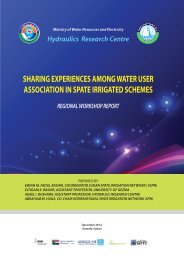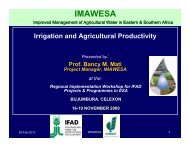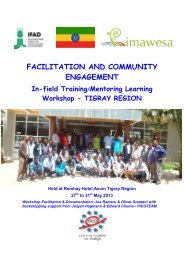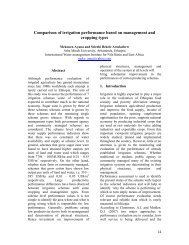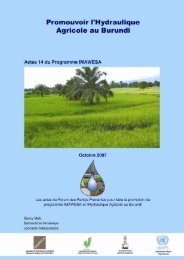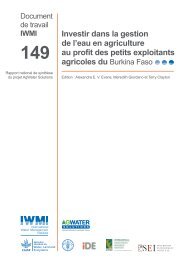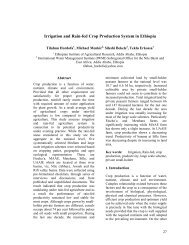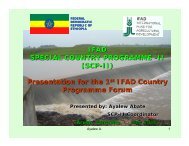Analysis of irrigation systems using comparative performance ...
Analysis of irrigation systems using comparative performance ...
Analysis of irrigation systems using comparative performance ...
You also want an ePaper? Increase the reach of your titles
YUMPU automatically turns print PDFs into web optimized ePapers that Google loves.
emedial works in the long term and achieving<br />
maximum returns on water (Woodro<strong>of</strong>e, 1993).<br />
State run farms, which include large-scale <strong>irrigation</strong><br />
<strong>systems</strong>, were reiterated as major components <strong>of</strong><br />
efforts to develop the country’s agricultural sector,<br />
notably in the Awash Valley. However,<br />
productivity <strong>of</strong> these top–down managed <strong>systems</strong><br />
over the decades has been disappointing—the farms<br />
have been beset by a number <strong>of</strong> environmental,<br />
technical and socio-economic constraints. The large<br />
scale <strong>systems</strong> in the Awash basin and elsewhere<br />
suffer from water management practices that have<br />
resulted in rising ground water tables and secondary<br />
soil salinisation where large tracts <strong>of</strong> land have<br />
gone out <strong>of</strong> production (EARO 2001; Paulos).<br />
Even if evaluating the existing <strong>irrigation</strong> <strong>systems</strong> is<br />
an old phenomenon in the other parts <strong>of</strong> the world;<br />
it has not been tried in Ethiopian large-scale farms.<br />
Hence, this study attempts to introduce the concept<br />
<strong>of</strong> <strong>comparative</strong> <strong>performance</strong> indicators as a tool to<br />
evaluate the <strong>performance</strong> <strong>of</strong> large-scale <strong>irrigation</strong>s<br />
in the Upper Awash valley.<br />
The indicators<br />
consumption, where total consumption includes<br />
water depletion from the hydrologic cycle through<br />
process consumption (ET), other evaporative losses<br />
(from fallow land, free water surfaces, weeds,<br />
trees), flows to sinks (saline groundwater and seas),<br />
and through pollution.<br />
We are interested in the measurement <strong>of</strong> production<br />
from irrigated agriculture that can be used to<br />
compare across <strong>systems</strong>. If only one crop is<br />
considered, production could be compared in terms<br />
<strong>of</strong> mass. The difficulty arises when comparing<br />
different crops, say wheat and tomato, as 1 kg <strong>of</strong><br />
tomato is not readily comparable to 1 kg <strong>of</strong> wheat.<br />
When only one <strong>irrigation</strong> system is considered, or<br />
<strong>irrigation</strong> <strong>systems</strong> in a region where prices are<br />
similar, production can be measured as net value <strong>of</strong><br />
production and gross value <strong>of</strong> production <strong>using</strong><br />
local values.<br />
Output per cropped area<br />
Pr oduction<br />
=<br />
Irrigated Cropped area<br />
(1)<br />
Nine indicators are developed related to the<br />
<strong>irrigation</strong> and irrigated agricultural system. The<br />
main output considered is crop production, while<br />
the major inputs are water, land, and finances.<br />
Indicators <strong>of</strong> Irrigated Agricultural Output<br />
The four basic <strong>comparative</strong> <strong>performance</strong> indicators<br />
relate output to unit land and water. These<br />
“external” indicators provide the basis for<br />
comparison <strong>of</strong> irrigated agriculture <strong>performance</strong>.<br />
Where water is a constraining resource, output per<br />
unit water may be more important, whereas if land<br />
is a constraint relative to water, output per unit land<br />
may be more important.<br />
Output per unit <strong>of</strong> <strong>irrigation</strong> water supplied and<br />
output per unit <strong>of</strong> water consumed are derived from<br />
a general water accounting framework (Molden et<br />
al, 1998). The water consumed in equation 4 on<br />
page 21 is the volume <strong>of</strong> process consumption, in<br />
this case evapotranspiration. It is important to<br />
distinguish this from another important water<br />
accounting indicator—output per unit total<br />
Output per unit command area<br />
Pr oduction<br />
=<br />
Command area<br />
Output per <strong>irrigation</strong> supply<br />
Pr oduction<br />
=<br />
Diverted irrigtion supply<br />
Output per unit water consumed<br />
Pr oduction<br />
=<br />
Volume <strong>of</strong> water consumed by ET<br />
Where,<br />
(2)<br />
(3)<br />
(4)<br />
78



